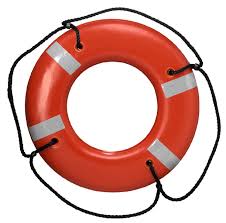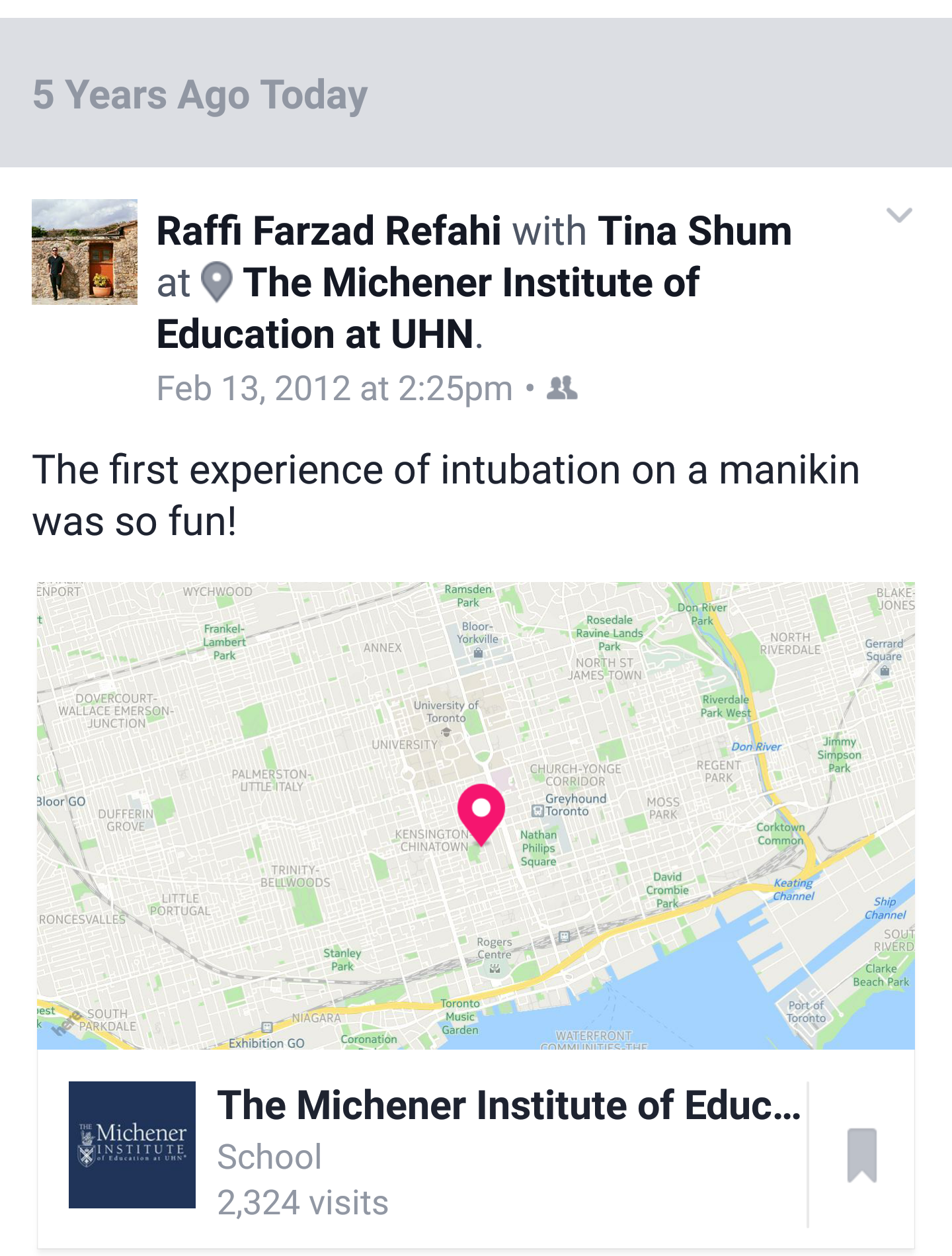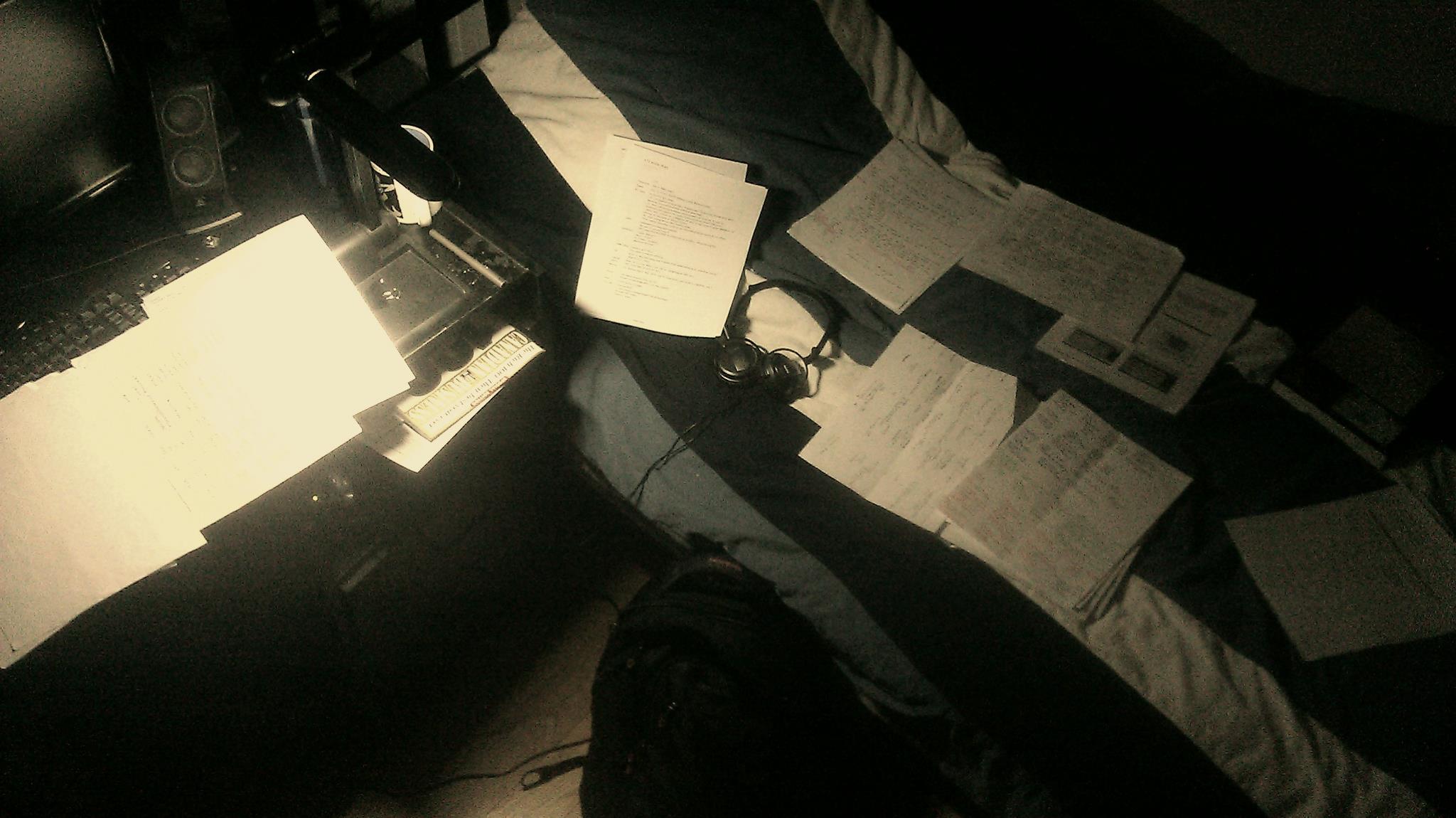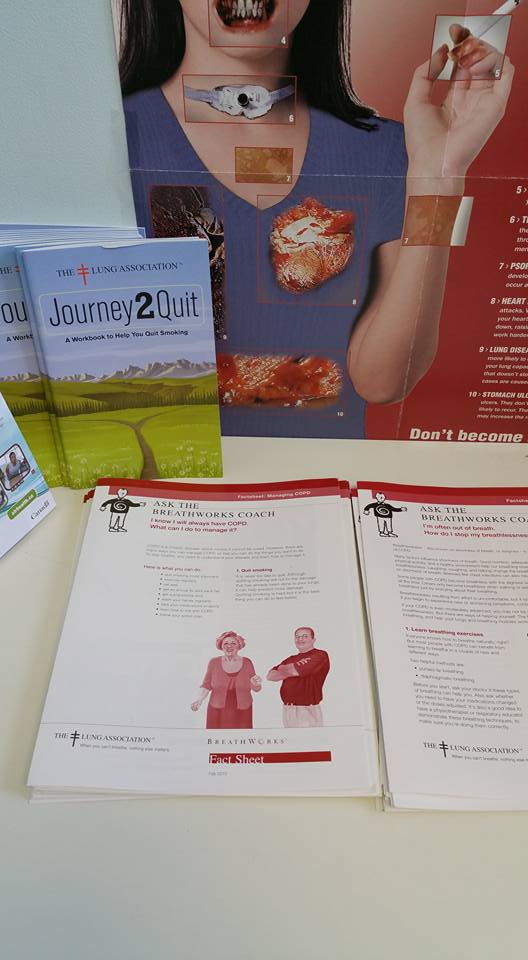Working on my presentation for the upcoming CSRT Conference in Halifax. Thursday May 11, 2017. 10:45 am. Leadership Forum.
Working with Multi-Generations in Health Care.
See you there!
Respiratory Therapy by Farzad Refahi
With a goal of improving the life of healthcare providers as individuals and as clinicians.
 Farzad Refahi Feb 17, 2017
Farzad Refahi Feb 17, 2017

“The first experience of intubation on a manikin was so fun!”
These were my initial thoughts after trying intubation on a manikin for the first time on Feb 13, 2012 at The Michener Institute. My first intubation in a simulation setting. “So Fun”. Reaching for the laryngoscope with the left hand, sliding the tongue to the left. Recalling to lift up and NOT to bend the wrist. To pass the tube through the cords. To establish an airway. To intubate. A palpable excitement in the clinical laboratory as my classmates took turns to attempt this skill. Somehow it made us feel powerful, and closer to becoming a Respiratory Therapist, an RT.
This post is a self-reflection, a personal opinion, and does not represent the thoughts and the beliefs of my employers. I will make references to intubation as a unique RT skill, without suggesting that it is the ultimate required intervention. Also, I will draw on my experiences and insights as a lifeguard and a respiratory therapist, without any attempts to fully describing the responsibilities of each job.
When I read my Facebook post from 5 years ago, I started to think about my role as an RT. I realized that my views and thoughts have shifted, or expanded to be more accurate. I had gone through the same realization some years ago about a similar case. I started recalling my training and work as a lifeguard.
To be a lifeguard. To recognize the signs of struggle, to make that dive, and to save someone. Many swimming classes and training sessions prepares one to become a lifeguard. The idea of being able to save someone is a strong motivation to jump through all the hurdles and requirements. However, when you complete the training sessions and start working as a lifeguard, you realize that the ability to ‘dive in and save’ , is only a very small part of your actual shift. Does that take away from the skills and abilities of a lifeguard? Absolutely not. But one quickly learns that there are many more processes in place to make someone a quality lifeguard. The meaning of ‘saving’ someone shifts and expands. Once trained, lifeguards are equipped with many skills to approach and intervene with the situation at hand. However, most of the shift is spent on preparation and monitoring. Yes. Lifeguards spend most of their time preventing the opportunity to do the glamorous ‘dive and save’. Time is spent to scan the swimming pools before the beginning of the shift: scanning for any loose bricks, sharp corners, water quality and levels. During the shift, they monitor any risky behaviour by the patrons. They move around to have a clear view of those in the water. Lifeguards have learned to expect and predicts certain patterns. In case of emergency, they use the skills and routines that they have spent hours practicing. Once the incident is dealt with, they spend time documenting and communicating with appropriate staff. The incidents are monitored to recognize any patterns.
I had a very similar insight when it came to practicing respiratory therapy. After finishing my undergraduate studies and then few years of respiratory therapy program, I became an RRT. I learned that if intubation is the required intervention then RTs are willing and ready to perform the task. However, just like my lifeguarding experience, a lot of effort is spent on recognition, monitoring and prevention. After performing any required intervention, RTs educate and follow-up to prevent the repeat of this incident. With additional knowledge and experience, one stops thinking about one specific event and start thinking about the bigger spectrum of care.
Let’s imagine that you are an RT responding to a page for intubation of an Asthma exacerbation. The initial nebulizer and oxygen therapy treatment has failed, and deterioration has continued; Intubation has been selected as the next intervention. You intubate and ventilate, and the team uses the appropriate pharmaceutical therapy to help the patient. Your job as an RT may have been done for that instance, but you soon realize that there is a whole system in place that will continue to take care of this patient. Your colleague may be called in during discharge to review an Asthma Action Plan with the patient. This patient goes home and returns to his/her daily life. He/she books an appointment with an RT, a certified respiratory educator, to discuss the recent events. During the session, spirometry is done to compare the current values with his/her baseline. A review of the current puffers is done. Puffer techniques are assessed, corrected and/or reviewed. The action plan is reviewed and modified as needed. A list of triggers is updated, and plans to prevent these triggers are discussed. Our patient is monitored by a team of RTs/CRE/Respirologist/MDs/nurses/Pharmacists who look after him/her. If all of the above fails, then we know there is a team of healthcare providers waiting in the emergency departments and ICUs to assist and treat such exacerbations. Preparation, monitoring, interventions, and follow ups.
Through my short RT career so far, I have worked in acute care, pulmonary function testing and sleep apnea education/CPAP. I have had the opportunity to view our role from a wide spectrum. It is comforting to know that this system of prevention, treatment, and follow up is active in all the settings. While this system is not perfect, there are caring people who are trying to make improvements. By thinking about the bigger image, and staying humble, we can be a better member of this spectrum of care.
In hindsight, the thought of diving in and rescuing someone via intubation seems glamorous and ‘fun’, however, it is but one aspect of being an RT. Respiratory Therapy field is expanding and we are the driving force behind it.
[End]
We said farewell to 2016 and welcomed 2017. After few days of celebration we returned to our regular schedule. Having a new year’s resolution is common and well established for many individuals. Creating a new year resolution is not a new concept, and can be linked back to 4000 years ago, in the ancient Babylon (1). We can all recall the elements of an effective goal setting/plan. SMART. Specific, Measurable, Attainable, Realistic and Timely. We have been exposed to effective planning throughout our academic and clinical training. However, I would like to remind you of an important step that will benefit both us and our patients. Planning for possible and upcoming obstacles will be the focus of this post. During my undergraduate studies, Kinesiology with a minor in Psychology, students were encouraged to explore possible obstacles that may hinder the performance and recovery of their patients. Let’s look at one scenario.
The client works in an administrative setting where the stress of producing end of month reports elevates his or her stress level. This anxiety may lead to an increased urge or temptation to variety of thoughts, actions, feelings and behaviours. Our client may end up working longer hours in the final days of the month, and resort to take-out and unhealthy eating habits. Also, in order to meet his/her deadlines, he/she skips the dedicated exercise time. If our patient is trying to quit smoking or recently has stopped smoking, stress may trigger an automatic impulse to reach for a cigarette. Also, if others in the office react and behave in the same unhealthy manner when faced with stress, there will be an added external confirmation and enabling. Now, if we sit down with the client and identify this monthly obstacle or challenge, we can better plan for it.
Meals: Packing healthy snacks and lunch/dinner so it is readily available. Benefits include saving money, one less thing to possibly to worry about, and providing the body with a well balanced energy and nutrients.
Exercise: Exercise helps to lower stress and improve mood, which allows individuals to remain calm and better focus on task on hand (2). Consider taking 30-minutes walk breaks, without the distraction of listening to the news, reading/replying to emails, talking on the phone, or watching a TV show/Netflix.
Smoking Cessation: By preventing or managing stress triggers when overwhelmed, individuals can better handle their cravings. Avoid accompanying colleagues who are going outside to smoke. (For other list of available resources check out: http://www.smoke-free.ca/pdf_1/smoking_guide_en.pdf )
When people become stressed, the fight or flight conditioning kicks in, their focus becomes narrowed, and they are more inclined to repeat what they have trained themselves to do. We can adopt the lessons from this case study and apply it to our lives. Take the time to analyse and identify the obstacles in our plans. Write them down. It may feel weird or silly to do this exercise but you will thank yourself in the long run. Create a list. (If X happens, then I can do A, B or C). Keep it simple. Break down each step into smaller parts. Keep track of your progress. Celebrate every small achievement in your path. Keep at it!
Farzad ‘Raffi’ Refahi
1. Bennett, Howard. Why do we make new year’s resolutions? Washington Post (online). Posted: December 31, 2015
https://www.washingtonpost.com/lifestyle/kidspost/why-do-we-make-new-years-resolutions/2012/12/21/08b56a2a-381e-11e2-b01f-5f55b193f58f_story.html?utm_term=.dfd45acd2199
2. Exercise and stress: Get moving to manage stress. Mayo-Clinic (Online). Posted: April 16, 2015
http://www.mayoclinic.org/healthy-lifestyle/stress-management/in-depth/exercise-and-stress/art-20044469

As it is the case for us Repertory Therapist, as is the case for a large portion of professions, Continuing Education (CE) is required and mandatory. Regulatory bodies, such as our The Canadian Society of Respiratory Therapists (CSRT), use CE to have us certified and registered members, be equipped with the latest skills and know-hows of our field and update us with on new and / or reformed practice guidelines.
In my three years of being a RT, I have already taken part in various CE programs, and so I believe it is time for some humble reflection on this matter.
I truly believe in the intention and goal of such CE structures. It is constructive. However, it does hold some specific limitations. My main concern about the CE system is that it takes a one size-fits-all approach. Take for instance, an RRT with a focus in neonatal ICU can register for an online courses which will help review the knowledge side but would lack the ‘hands on’ evaluations, as well the in-person teaching or feedback (i.e. proficiency) which I find to be essential for our stream of healthcare profession. During my time at The Michener Institute, as I am sure it has / was the case in your educational institution, one quickly realizes that while the theory becomes palpable when it is later combined with the practical, hands-on training, and the feedback from teachers to better adjust to strengths and weaknesses that each and every RT student confronts.
Another limitation of the current system is lack of universal standard. This passive approach has allowed some courses, e-module and conference materials to be out of date, and lack sufficient and quality material.
Furthermore the cost-benefit of online versus in-person training has to also be taken into consideration. The online courses and modules to be more cost and time efficient, not to mention conveniently accessible, but it lacks the interprofessional opportunity and technical aspects that is incorporated in the in-person workshops and conferences. However, despite this definitive bright side to the in-person training, one cannot ignore its time and financial burden. One needs to pay higher fees for conferences/workshops than online courses, coupled with the burden of having to request time off work which means wage loss. As I had to maintain a part-time job along with my full-time RT job, for most of my career in this profession, I really appreciated the flexibility of online courses, as it allowed me to maintain a better work-life balance. However I really value the direct and immediate feedback and interaction with the instructions during the workshops and conferences. Recent research stresses the importance of associations taking into account the preferences of its members for CE courses (i.e., online versus in-person). Researchers have studied medical CE courses and have suggested a transition to Professional Development portfolio that encourages clinicians to identify goals and to take relevant courses in selected pathways.[1] An example of such portfolio approach can be found with the existing structure of The College of Respiratory Therapists of Ontario (CRTO).
There are numerous frameworks, theoretical approaches to Continuing Education and Professional Development Portfolios which are either implemented or being considered and which deserve comparison and further analysis. If you are interested to learn more about this topic I recommend looking at Continuing Education in the Health Professions, by Gail Warden and colleagues, published in 2010 through The National Academies Press. You can access this document online by clicking on the following link: https://www.nap.edu/catalog/12704/redesigning-continuing-education-in-the-health-professions .
As you may know, there has been some recent changes to CRTO’s Professional Development and QA process. I strongly recommend that you check out their website for additional information.
| In Ontario and for CRTO:
“The CRTO does not require any number of annual CE credits. As an RT in Ontario, the CRTO QA Program requires you to maintain your PORTfolio on an ongoing basis, and complete any other assessment when requested. More information on the CRTO QA Program can be found on the CRTO website under QA Practice. Changes are currently being made to the existing QA program, so please stay tuned. ”
|
| For Alberta and College and Association of Respiratory Therapists of Alberta:
” Please refer to the continuing competency package in the secure members section of www.carta.ca ”
|
| For Saskatchewan College of Respiratory Therapists:
“Visit www.SCRT.ca -> Resources -> SCRT Continuing Education Program |
| For Manitoba Association of Registered Respiratory Therapists Inc. :
” http://marrt.org/site/cc?nav=04 –> click on the provided link on the page for the PDF file. ”
|
| For l’Ordre professionnel des inhalothérapeutes du Québec :
” You can find all the information with the following links :
|
| Visit the general website for the following organizing bodies: New Brunswick Association of Respiratory Therapists Inc. , Newfoundland and Labrador College of Respiratory Therapy , Nova Scotia College of Respiratory Therapists , and New Brunswick Association of Respiratory Therapists Inc. .
|
Special thanks to the following individuals for their help with this post:
Bryan Buell (CARTA),
Ardis K Monarchi (SCRT),
Carole Hamp (CRTO),
Lee Hurton (MARRT),
Catherine Larocque (OPIQ), and
Katherine Nollet (CSRT).
By Farzad Refahi HBsc RRT CRE
Edited by Farhad Refahi HBA, MA Public Policy
Dec 09, 2016
’Respiratory Therapy By Farzad’
FarzadRefahi.com
Resources and suggested reading:
Today is #WorldCOPDday . #Educate , #Prevent , #Diagnose and #Manage.
“While 4% of Canadians aged 35 to 79 self-reported being diagnosed with chronic obstructive pulmonary disease (COPD), direct measurements of lung function from the Canadian Health Measures Survey (CHMS) indicate that 13% of Canadians had a lung function score indicative of COPD.” [1]
Check out Lung Association’s website for list of free resources:
http://lung.healthdiary.ca/Guest/SearchResults.aspx?C=24&M=0&K=&N=&S=1&P
Educate yourself about smoking cessation information with this free module by The Ontario Tobacco Research Unit :
http://otru.org/training/online-course/cessation-module/
Help your patients quit smoking:
http://www.hc-sc.gc.ca/hc-ps/pubs/tobac-tabac/road-voie-eng.php
COPD Management Guidelines:
GOLD http://goldcopd.org/global-strategy-diagnosis-management-prevention-copd-2016/

Reference:
1. Chronic obstructive pulmonary disease in Canadians, 2009 to 2011. Statistics Canada. http://www.statcan.gc.ca/pub/82-625-x/2012001/article/11709-eng.htm